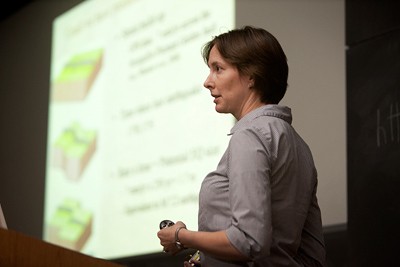Devastation in Haiti had human causes, too, panelists say
By Lauren Gold
Situated at the heart of a geologically active region and with a well-documented history of earthquakes, Haiti has long been known to be at risk for a major quake.
But the tragedy surrounding this month's earthquake is the result of human failure as much as natural disaster, said four geology and engineering faculty members in a panel discussion Jan. 25 in Phillips Hall, adding that there is hope for preventing similar tragedies in the future.
The discussion on the science, engineering and social implications of the Haiti earthquake was the first of several events around campus focusing on the earthquake in Haiti scheduled for this week.
Hispaniola, the island that includes Haiti and the Dominican Republic, is at the heart of a geologically active region, said Rick Allmendinger, professor of earth and atmospheric sciences (EAS).
"The Caribbean plate itself is acting a little like a herniated disc, which is being squeezed out between North and South America; and it's this shearing motion between the Caribbean plate and North America that produces a long and well documented history of large earthquakes in the area," he said.
It's been almost 60 years since the last earthquake in the region, he said -- a factor that at once increased the risk and led to complacency.
"Humans have a short frame of reference -- if there hasn't been any activity along a fault in 200 years, we tend to think that there won't be any activity in the future," he said. "Geologically, that's just the wrong way to think about it."
Panelist Rowena Lohman, assistant professor of EAS, added that the potential for a very large earthquake in the Port-au-Prince area was noted as recently as 2008. But predicting exactly when an earthquake will occur is still not possible.
Some early warning systems in place in Japan and Mexico use the difference between the detection of the first seismic wave and the slightly slower surface wave to give a few minutes' notice before an earthquake, Lohman said; but because Port-au-Prince lies almost directly over the fault line, such a system would not have worked in this case.
But the earthquake didn't have to be catastrophic, said panelist Tom O'Rourke, the Thomas R. Briggs Professor of Civil and Environmental Engineering; and modern building codes requiring steel reinforcement could have prevented much of the damage.
"Port-au-Prince has extraordinarily vulnerable buildings. There really is no building code in Port-au-Prince or Haiti that serves as a model where people design on it," O'Rourke said.
EAS associate professor Chris Andronicos noted that poverty magnifies the potential for a natural disaster to cause humanitarian catastrophe.
"Poverty is really a very severe underlying problem that is not often addressed in disaster mitigation," he said. "The major factors that control the impact on humanity of [natural] disasters are human in character, and they really revolve around our vulnerability -- how stable is our society, our government ... and how able are we to respond to mitigate the impacts of disaster when they occur?"
According to data from the United Nations, he said, 94 percent of all people who have been killed by disasters since 1975 have been poor. Immediate aid is critical, he said, but so is a long-term focus on building a strong, independent Haitian government that can provide services to its people.
The discussion was sponsored by the Departments of Earth and Atmospheric Sciences and of Natural Resources, the School of Civil and Environmental Engineering, and the American Indian Program.
Get Cornell news delivered right to your inbox.
Subscribe
